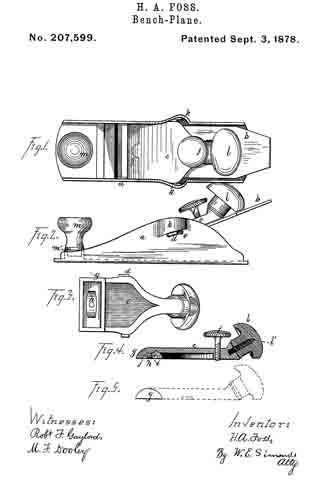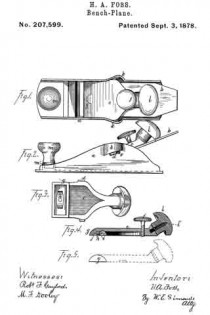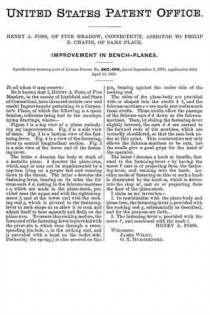No. 207,599 – Improvement In Bench-Planes (Henry A. Foss) (1878)

UNITED STATES PATENT OFFICE.
_________________
HENRY A. FOSS, OF PINE MEADOW, CONNECTICUT, ASSIGNOR TO PHILIP E. CHAPIN, OF SAME PLACE.
IMPROVEMENT IN BENCH-PLANES.
_________________
Specification forming part of Letters Patent No. 207,599, dated September 3, 1878; application filed April 15, 1878.
_________________
To all whom it may concern:
Be it known that I, HENRY A. FOSS, of Pine Meadow, in the county of Litchfield and State of Connecticut, have invented certain new and useful Improvements pertaining to a Carpenter’s Plane, of which the following is a specification, reference being had to the accompanying drawings, where —
Figure 1 is a top view of a plane embodying my improvements. Fig. 2 is a side view of same. Fig. 3 is a bottom view of the fastening-lever. Fig. 4 is a view of the fastening-lever in central longitudinal section. Fig. 5 is a side view of the lower end of the fastening-lever.
The letter a denotes the body or stock of a metallic plane. b denotes the plane-iron, which may or may not be supplemented by a cap-iron lying on a proper bed and running down to the throat. The letter c denotes the fastening-lever, bearing on its sides the fulcrum-ears d d, resting in the fulcrum-mortises e e, which are made in the plane-stock, provided near the upper end with the tightening-screw f and at the lower end with the rocking end g, which is pivoted to the fastening-lever in such shape as to allow it to rock and adjust itself to bear squarely and flatly on the plane-iron. To secure this rocking motion, the lower end of the fastening-lever is provided with the pivot-pin h, which runs through a corresponding pin-hole, i, in the rocking end, and is provided with a head on the under side. Preferably the spring j is also secured on this pin, bearing against the under side of the rocking end.
The sides of the plane-body are provided with or shaped into the swells k k, and the fulcrum-mortises e e are made just underneath these swells. These swells allow the passage of the fulcrurn-ears d d down to the fulcrum-mortises. Then, by sliding the fastening-lever slightly forward, the ears d d are carried to the forward ends of the mortises, which are inwardly shouldered, so that the ears lock under at this point. This construction not only allows the fulcrum-mortises to be cast, but the swells give a good gripe for the hand of the operator.
The letter l denotes a knob or handle, fastened to the fastening-lever c by having the screw l’ cast in or projecting from the fastening-lever, and running into the knob. Another mode of fastening on this or such a knob is illustrated by the knob m, which is driven into the ring m’, cast on or projecting from the floor of the plane-stock.
I claim as my invention —
1. In combination with the plane-body and plane-iron, the fastening-lever c, provided with the rocking end g, substantially as described, and for the purpose set forth.
2. The fastening-lever c, provided with the screw l’, and combined with the knob l.
HENRY A. FOSS.
Witnesses:
JAMES WILEY,
O. T. HUNGERFORD.





